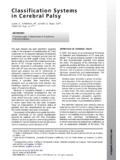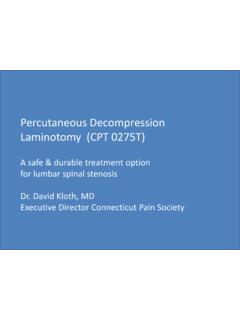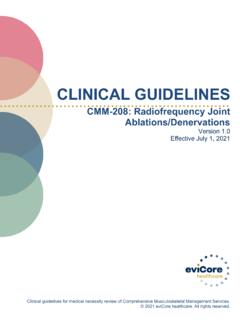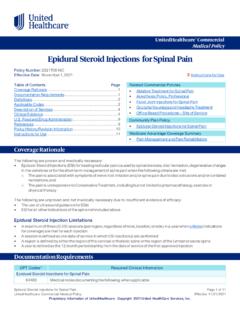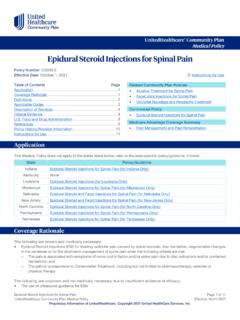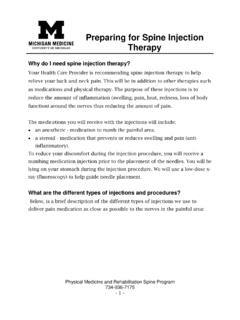Transcription of Epidural Steroid Injections Medications and Dosages
1 DATE: October 2017. OREGON HEALTH AND SCIENCE UNIVERSITY. OFFICE OF CLINICAL INTEGRATION AND EVIDENCE-BASED PRACTICE. Evidence-Based Practice Summary Epidural Steroid Injections Medications and Dosages Prepared for: Ashley Valentine, MD. Authors: Marcy Hager, MA. BACKGROUND. The underlying mechanism of action of epidurally administered Steroid and local anesthetic Injections is not well understood (Conn 2009). It is believed that the achieved neural blockade alters or interrupts nociceptive input, reflex mechanism of the afferent fibers, self- sustaining activity of the neurons, and the pattern of central neuronal activities (Boswell 2007; Manchikanti 2002). Few research studies have been conducted to determine the optimal dose and schedule for dexamethasone with Epidural Steroid Injections . Additionally, there has been little research done to determine the type, dose and/or duration of local anesthetics to use with Epidural Steroid Injections to improve clinical outcomes.
2 This evidence brief was conducted to synthesize the literature available on the optimal dose and schedule for dexamethasone and the type, dose, duration of local anesthetics for use with Epidural Steroid Injections . ASK THE QUESTION. Question 1: In patients receiving Epidural Steroid Injections , what is the minimum-effective dose of dexamethasone to relieve pain? Question 2: In patients receiving Epidural Steroid Injections , what local anesthetic (type, dose, duration) is associated with improved clinical outcomes and/or harms (ie weakness, cardiotoxicity, osteonecrosis, other)? SEARCH FOR EVIDENCE. Databases included Ovid MEDLINE, MEDLINE inprocess, the Cochrane Central Register of Controlled Trials (CCRCT) & Cochrane Database of Systematic Reviews (CDSR). 1. exp Injections , Epidural / (3431). Office of Clinical Integration and EBP, 2017 1. Oregon Health and Science University DATE: October 2017. 2. exp Analgesia, Epidural / (7707). 3. (epidur* adj3 (inject* or infus* or administ* or analges* or (pain* adj3 relie*))).
3 Mp. [mp=title, abstract, original title, name of substance word, subject heading word, keyword heading word, protocol supplementary concept word, rare disease supplementary concept word, unique identifier, synonyms] (15176). 4. 1 or 2 or 3 (15788). 5. exp Steroids/ (832041). 6. 1 and 5 (773). 7. Dose-Response Relationship, Drug/ (391723). 8. (epidur* adj5 ( Steroid * or dexametha*)).mp. [mp=title, abstract, original title, name of substance word, subject heading word, keyword heading word, protocol supplementary concept word, rare disease supplementary concept word, unique identifier, synonyms] (1170). 9. 7 and 8 (19). 10. exp Pain/ (364190). 11. exp pain management/ (27559). 12. exp pain measurement/ (77393). 13. 10 or 11 or 12 (400215). 14. 8 and 13 (751). 15. 6 or 9 or 14 (1162). 16. limit 15 to english language (1084). 17. limit 16 to (meta analysis or systematic reviews) (100). 18. limit 16 to (controlled clinical trial or guideline or randomized controlled trial) (197).
4 19. limit 16 to (comparative study or evaluation studies or validation studies) (130). 20. exp Epidemiologic Studies/ (2177321). 21. 16 and 20 (342). 22. 17 or 18 or 19 or 21 (549). 23. 16 not 22 (535). Filters/limits included articles published in English in the last 15 years. CRITICALLY ANALYZE THE EVIDENCE. Questions 1: In patients receiving Epidural Steroid Injections , what is the minimum-effective dose of dexamethasone to relieve pain? Office of Clinical Integration and EBP, 2017 2. Oregon Health and Science University DATE: October 2017. The literature search resulted in a number of studies including dexamethasone, although few studies were found analyzing the different doses between treatment groups and/or the most effective dose for relieving pain. One systematic review and two randomized-controlled studies (RCT) were found researching the most effective dose to relieve pain. One systematic review (De Oliveira 2011) was conducted to evaluate the dose-dependent analgesic effect of perioperative dexamethasone.
5 In the meta-analysis that included 24 RCTs with approximately 2,500. patients, dexamethasone > was found to reduce postoperative pain and opioid consumption. One RCT (Ahadian 2011) investigated the efficacy, dose-response profile, and safety of three doses of Epidural dexamethasone. Subjects were randomized to receive transforaminal Epidural dexamethasone 4mg, 8mg, or 12mg. The primary outcome for this measure was a reduction in radicular pain according to the visual analog scale from baseline. The study found there was no statistical difference between groups for either measure (all P values < ). The last RCT (Hong 2017) included investigated the effects and optimal dose of Epidural dexamethasone on pain after major abdominal surgery. Patients were randomized to receive one of three treatment regimens: Dexamethasone 5mg (1mL) with normal saline (1mL) (Group D) or dexamethasone 10 mg (2mL) (Group E) or 2mL of normal saline (Group C) mixed with 8mL of ropivacaine as a loading dose.
6 The resting and effort visual analogue scale (VAS) was significantly lower in Group E compared to Group C at every time point through the study period. Only the resting VAS in Group D was lower at 2 hours and 6 hours after surgery. In conclusion, there is moderate quality evidence for the use of dexamethasone to relieve pain. The studies demonstrated that dexamethasone was effective at reducing pain, but is it unclear the minimum-effective dosage to achieve the best outcomes. Overall, studies did not demonstrate a statistically significant reduction in pain between treatment groups receiving different doses. Question 2: In patients receiving Epidural Steroid Injections , what local anesthetic (type, dose, duration) is associated with improved clinical outcomes and/or harms (ie weakness, cardiotoxicity, osteonecrosis, other)? There was limited literature found evaluating what local anesthetic (type, dose, duration) with Epidural Steroid Injections is associated with improved clinical outcomes and/or harms.
7 The majority of the research compared the effects of Epidural Steroid Injections with or without local anesthetics. This brief includes studies that reported the type, dose or duration of local anesthetics used in treatment and includes ten studies: five systematic reviews, one RCT and four non-randomized studies. One systematic review (Conn 2009) evaluated the effect of caudal Epidural Injections with or without steroids in managing various types of chronic low back and lower extremity pain. Eighteen RCTs and twenty observational studies were included in the systematic review using a variety of doses and durations of local anesthetics. One of the randomized trials evaluated spinal stenosis with or without steroids with local anesthetic (lidocaine ) showed positive results for short- and long-term relief. The included observational studies also showed positive short-term and long-term improvement. Another systematic review (Diwan 2012) evaluated the effect of cervical interlaminar Epidural Injections in managing various types of chronic neck and upper extremity pain.
8 For cervical disc herniation, the review authors rated the evidence as good for cervical Epidural with local anesthetics and steroids, whereas the rated with local anesthetic only as fair . For axial or Office of Clinical Integration and EBP, 2017 3. Oregon Health and Science University DATE: October 2017. discogenic pain, the review authors rated evidence as fair for local anesthetic, with or without steroids. For spinal stenosis, the review authors rated the evidence as fair for local anesthetic, with or without steroids. And for postsurgery syndrome, the review authors rated the evidence as fair for local anesthetic, with or without steroids. The systematic review conducted by Manchikanti assessed the efficacy of three categories of Epidural Injections for lumbar and spinal stenosis performed with saline with steroids, local anesthetic alone, or steroids with local anesthetic. The review found that adding bupivacaine to steroids showed very short-term (three-six weeks) effectiveness in three trials with 173 patients, whereas two trials with 142 patients reported a lack of effectiveness.
9 There were seven trials assessing lidocaine as a sole agent or lidocaine with steroids and 3 trials assessing bupivacaine alone in comparison to bupivacaine with Steroid . All three of the bupivacaine trials showed positive results with similar results with bupivacaine combined with Steroid to avoid surgical interventions. Based on a qualitative synthesis of evidence of seven active-controlled trials comparing lidocaine to lidocaine with Steroid , effectiveness was equal in both groups except in disc herniation where potential superiority was demonstrated. Six studies with 649 patients were utilized for pain improvement ratings, comparing lidocaine to lidocaine with Steroid . They showed no difference in pain improvement between both groups at three or 12 months. Functional status was also assessed with inclusion of six studies at three months and seven studies at 12 months showing no difference in functional improvement between lidocaine alone or lidocaine with Steroid at three or 12 months.
10 This analysis showed the effectiveness of lidocaine and lidocaine with Steroid for pain relief and functional status at three months and also 12 months with results slightly favoring local anesthetic alone. Another systematic review (Liu 2015) investigated the effectiveness and safety of Epidural Steroid Injections in patients with lumbar spinal stenosis (LSS). The Epidural local anesthetic injection group in the analysis reported no significant difference for most common measures. The final systematic review (Meng 2015) included presented a current, comprehensive picture of Epidural Injections of anesthetic with steroids compared to those using local anesthetic alone. Thirteen RCTs involving 1,465 patients were include in the meta-analysis; Group I included patients administered with Epidural Injections of anesthetic with steroids and Group 2 included patients administered with local anesthetic alone. The overall number of Injections per year was + and + with average total relief per year of + and + weeks in groups 1 and 2, respectively, and the opioid intakes decreased from baseline by and mg, respectively.







